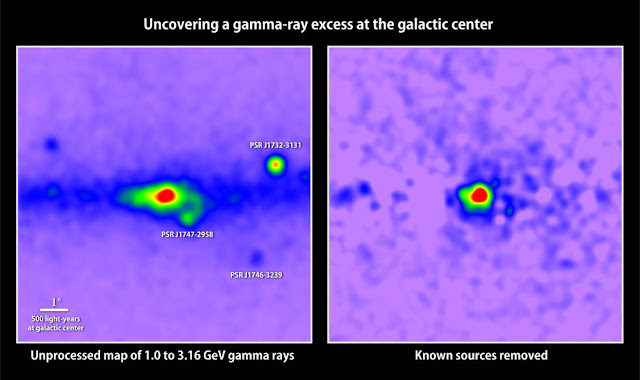 |
| Image: At left is a map of gamma rays with energies between 1 and 3.16 GeV detected in the galactic center by Fermi's LAT; red indicates the greatest number. Prominent pulsars are labeled. Removing all known gamma-ray sources (right) reveals excess emission that may arise from dark matter annihilations. Credits: T. Linden, Univ. of Chicago |
Observations by the Fermi-LAT have uncovered a bright, spherically symmetric excess surrounding the center of the Milky Way galaxy. The spectrum of the gamma-ray excess peaks sharply at an energy ~2 GeV, exhibiting a hard spectrum at lower energies, and falls off quickly above an energy ~5 GeV. The spectrum of the excess above ~10 GeV is potentially an important discriminator between different physical models for its origin.
In a recent paper (Linden et al. 2016) the authors focus on observations of the gamma-ray excess at energies exceeding 10 GeV, finding:
- a statistically significant excess remains in the energy range 9.5-47.5 GeV, which is not degenerate with known diffuse emission templates such as the Fermi Bubbles
- the radial profile of the excess at high energies remains relatively consistent with data near the spectral peak
- the data above ~5 GeV prefer a slightly greater ellipticity with a major axis oriented perpendicular to the Galactic plane.
Using the recently developed non-Poissonian template fit, they find mild evidence for a point-source origin for the high-energy excess, although given the statistical and systematic uncertainties they show that a smooth origin of the high-energy emission cannot be ruled out.
The authors note that if the GeV-scale peak of the excess were due to prompt photon emission from pulsars in the Galactic Center (GC) region, a high-energy tail could potentially be generated by the inverse-Compton scattering (ICS) of electrons produced by the spindown of those same pulsars.
If dark matter (DM) annihilations were responsible for the full excess, the mass of the DM particle must be sufficiently high to produce γ-rays at energies up to ~ 50 GeV - disfavoring very light models of DM.
The slight evidence for elongation perpendicular to the Galactic plane also suggests a possible association with or contamination by the Fermi Bubbles (giant lobes expanding from our galaxy - see figure), which may have presently unmodeled features close to the Galactic Center.
 |
| Image: Fermi Bubbles at the center of the Milky way. Bubbles extend 50,000 light-years, or roughly half of the Milky Way's diameter, as shown in this illustration. Credit: NASA's Goddard Space Flight Center |
If a mechanism associated with the Bubbles is responsible for the bulk of the high-energy emission we observe, it would need to yield a signal centered on and peaked toward the Galactic Center. It is worth noting that in the context of DM interpretations of the Galactic Center Excess (GCE), a contamination of the high-energy γ-ray emission by the Fermi Bubbles is well-motivated, as it is difficult for DM models to produce a γ-ray morphology that is more elliptical at higher γ-ray energies.
Future studies which theoretically motivate a morphological model for the Bubbles spectrum near the GC are thus imperative to resolving this possible degeneracy.
- Linden et al. 2016 (preprint) - The High-Energy Tail of the Galactic Center Gamma-Ray Excess (arXiv)
Comments
Post a Comment